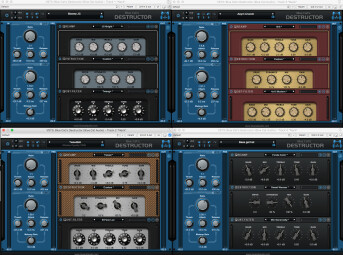Ever since we started this series of articles, there's one thing we've repeated over and over again: the main flaw of almost any home studio is room acoustics. However, for some instruments you can bypass this issue completely, and it just so happens that electric guitar is a textbook case. Let's take a look at the different possibilities you have...

Hardware solutions
I’ll begin with the hardware solutions. As you can surely imagine, the most versatile amp emulators are obviously the most expensive ones, too. Nevertheless, the investment might be worth it because it will allow you to take all yours sounds with you anywhere you go, be it for onstage or in the studio. Now, I don’t want nor have the time to re-invent the wheel on this topic, especially since you can consult the results of the nice little poll that Audiofanzine’s expert in the topic ran last month!
If these toys are all out of your reach moneywise, there are heaps of other solutions which are much more affordable. Take, for instance, the excellent Le Clean, Le Crunch and Le Lead by Two Notes Audio Engineering, or Tech 21 products like Blonde V2 or SansAmp GT2. With any of this you ought to be able to get some very decent results, although your choice of sounds will obviously be more limited. Consequently, it would be wise of you to test as many models as you can to see which one matches better “your sound” before you decide to fork out any money.
Finally, if you are happy with your amp head’s sound but want to spare having to record it with a mic, speaker hardware emulators were made for you! There’s a plethora of options, so you might want to check out the results of this other poll we ran some months ago. You’ll notice that, once again, Two Notes Audio Engineering is among the top choices, which is certainly no accident, considering their expertise.
Software solutions
Given the gargantuan amount of racks and pedals dedicated to amp simulation for electric guitar, it’s only logical to have just as many options in software form. And, once again, you favorite site has published several articles on the topic, like these lists of the top solutions, both paid and free. That said, they are a bit outdated… In fact, I think most you would agree with me when I say that Native Instruments’ Guitar Rig in its current version is certainly not anymore among the top. So, if you allow me, here’s my personal top three for may 2018.
On my list, the fourth version of IK Multimedia’s Amplitube gets third place. The sound is really good and it couldn’t be easier to use. The only con is that this plug-in induces a latency that is as big as the buffer setting of your audio interface. Plus, you’ll have to visit the “Custom Shop” to get the latest emulations, which can make your budget increase rapidly.
Second is another amp created in Italy, the Overloud TH3. It has an extremely wide sound palette and, contrary to the IK Multimedia, doesn’t induce any additional latency and has no in-app purchases.
Finally, the best option to my ears is Destructor by French software manufacturer Blue Cat Audio. Not only does it provide a remarkable quality at a more than reasonable price, it isn’t limited to the world of electric guitar and can also be used in other cases. Do note that Blue Cat Audio also introduced recently a new software dedicated to guitar and bass called Axiom. Unfortunately I haven’t had the time to really test it in depth, but it makes a very good impression at first glance: it combines the amp emulations of Destructor with the possibility to load up to 32 processors of the 40 built-in ones, among which is the superb Late Replies, and also from your personal plug-in collection! Interesting, isn’t it?
Before wrapping up, there is this one last plug-in which I would like to mention, even though it isn’t really a guitar amp emulator, it’s just a “simple” speaker emulator: the Torpedo PI-101 WOS III by Two Notes Audio Engineering. No, I’m not a shareholder in the company, but in my opinion it’s the best in its category, besides being the perfect match for the software tools mentioned above.
This list is obviously entirely subjective and you don’t have to believe everything I say. But I do invite you to try out the demo versions of the above plug-ins to make up your own opinion. Having the opportunity to test run these beauties in the comfort of your home studio is certainly a big advantage over the hardware versions which you shouldn’t neglect!
That’s it for today, Oh, and you probably noticed I didn’t mention any freeware tools… True, because I don’t have enough experience with any of them to give you knowledgeable advice. But I’m sure many among you do have something to say about them, don’t you? So don’t be shy and leave your suggestions in the comments! Thank you in advance!


